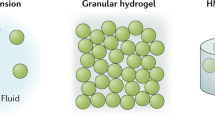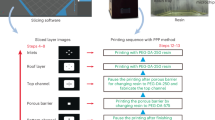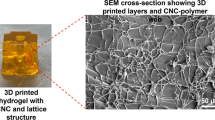Abstract
3D printing has been shown to be a robust and inexpensive manufacturing tool for a range of applications within biomedical science. Here we report the design and fabrication of a 3D printer-enabled microfluidic device used to generate cell-laden hydrogel microspheres of tunable sizes. An inverse mold was printed using a 3D printer, and replica molding was used to fabricate a PDMS microfluidic device. Intersecting channel geometry was used to generate perfluorodecalin oil-coated gelatin methacrylate (GelMA) microspheres of varying sizes (35–250 µm diameters). Process parameters such as viscosity profile and UV cross-linking times were determined for a range of GelMA concentrations (7–15% w/v). Empirical relationships between flow rates of GelMA and oil phases, microspheres size, and associated swelling properties were determined. For cell experiments, GelMA was mixed with human osteosarcoma Saos-2 cells, to generate cell-laden GelMA microspheres with high long-term viability. This simple, inexpensive method does not require the use of traditional cleanroom facilities and when combined with the appropriate flow setup is robust enough to yield tunable cell-laden hydrogel microspheres for potential tissue engineering applications.



Similar content being viewed by others
References
X. Zhao, S. Liu, L. Yildirimer, H. Zhao, R. Ding, H. Wang, W. Cui, and D. Weitz: Injectable stem cell-laden photocrosslinkable microspheres fabricated using microfluidics for rapid generation of osteogenic tissue constructs. Adv. Funct. Mater. 26, 2809 (2016).
V. van Duinen, S.J. Trietsch, J. Joore, P. Vulto, and T. Hankemeier: Microfluidic 3D cell culture: From tools to tissue models. Curr. Opin. Biotechnol. 35, 118 (2015).
A. Kang, J. Park, J. Ju, G.S. Jeong, and S-H. Lee: Cell encapsulation via microtechnologies. Biomaterials 35, 2651 (2014).
Y-C. Lu, W. Song, D. An, B.J. Kim, R. Schwartz, M. Wu, and M. Ma: Designing compartmentalized hydrogel microparticles for cell encapsulation and scalable 3D cell culture. J. Mater. Chem. B 3, 353 (2015).
K. Yue, G. Trujillo-de Santiago, M.M. Alvarez, A. Tamayol, N. Annabi, and A. Khademhosseini: Synthesis, properties, and biomedical applications of gelatin methacryloyl (GelMA) hydrogels. Biomaterials 73, 254 (2015).
W.H. Tan and S. Takeuchi: Monodisperse alginate hydrogel microbeads for cell encapsulation. Adv. Mater. 19, 2696 (2007).
D. Dupin, S. Fujii, S.P. Armes, P. Reeve, and S.M. Baxter: Efficient synthesis of sterically stabilized pH-responsive microgels of controllable particle diameter by emulsion polymerization. Langmuir 22, 3381 (2006).
M. Antonietti, W. Bremser, D. Mueschenborn, C. Rosenauer, B. Schupp, and M. Schmidt: Synthesis and size control of polystyrene latices via polymerization in microemulsion. Macromolecules 24, 6636 (1991).
A. Kumachev, J. Greener, E. Tumarkin, E. Eiser, P.W. Zandstra, and E. Kumacheva: High-throughput generation of hydrogel microbeads with varying elasticity for cell encapsulation. Biomaterials 32, 1477 (2011).
J.W. Kim, A.S. Utada, A. Fernández-Nieves, Z. Hu, and D.A. Weitz: Fabrication of monodisperse gel shells and functional microgels in microfluidic devices. Angew. Chem. 119, 1851 (2007).
V.L. Workman, S.B. Dunnett, P. Kille, and D. Palmer: Microfluidic chip-based synthesis of alginate microspheres for encapsulation of immortalized human cells. Biomicrofluidics 1, 014105 (2007).
T. Li, L. Zhao, W. Liu, J. Xu, and J. Wang: Simple and reusable off-the-shelf microfluidic devices for the versatile generation of droplets. Lab Chip 16, 4718 (2016).
A.K. Au, W. Huynh, L.F. Horowitz, and A. Folch: 3D-printed microfluidics. Angew. Chem., Int. Ed. 55, 3862 (2016).
N. Bhattacharjee, A. Urrios, S. Kang, and A. Folch: The upcoming 3D-printing revolution in microfluidics. Lab Chip 16, 1720 (2016).
P.J. Kitson, M.H. Rosnes, V. Sans, V. Dragone, and L. Cronin: Configurable 3D-printed millifluidic and microfluidic ‘lab on a chip’reactionware devices. Lab Chip 12, 3267 (2012).
S. Waheed, J.M. Cabot, N.P. Macdonald, T. Lewis, R.M. Guijt, B. Paull, and M.C. Breadmore: 3D printed microfluidic devices: Enablers and barriers. Lab Chip 16, 1993 (2016).
L.D. Albrecht, S.W. Sawyer, and P. Soman: Developing 3D scaffolds in the field of tissue engineering to treat complex bone defects. 3D Print. Addit. Manuf. 3, 106 (2016).
K.M. Ogden, C. Aslan, N. Ordway, D. Diallo, G. Tillapaugh-Fay, and P. Soman: Factors affecting dimensional accuracy of 3-D printed anatomical structures derived from CT data. J. Digit. Imag. 28, 654 (2015).
L. Yang, S.V. Shridhar, M. Gerwitz, and P. Soman: An in vitro vascular chip using 3D printing-enabled hydrogel casting. Biofabrication 8, 035015 (2016).
S. Sawyer, M. Oest, B. Margulies, and P. Soman: Behavior of encapsulated saos-2 cells within gelatin methacrylate hydrogels. J. Tissue Sci. Eng. 7, 2 (2016).
Y.X. Chen, S. Yang, J. Yan, M-H. Hsieh, L. Weng, J.L. Ouderkirk, M. Krendel, and P. Soman: A novel suspended hydrogel membrane platform for cell culture. J. Nanotechnol. Eng. Med. 6, 021002 (2015).
F. Tamimi, P. Comeau, D. Le Nihouannen, Y. Zhang, D. Bassett, S. Khalili, U. Gbureck, S. Tran, S. Komarova, and J. Barralet: Perfluorodecalin and bone regeneration. Eur. Cell. Mater. 25, 22 (2013).
V. Chokkalingam, B. Weidenhof, M. Krämer, W.F. Maier, S. Herminghaus, and R. Seemann: Optimized droplet-based microfluidics scheme for sol–gel reactions. Lab Chip 10, 1700 (2010).
D. Kumar, I. Gerges, M. Tamplenizza, C. Lenardi, N.R. Forsyth, and Y. Liu: Three-dimensional hypoxic culture of human mesenchymal stem cells encapsulated in a photocurable, biodegradable polymer hydrogel: A potential injectable cellular product for nucleus pulposus regeneration. Acta Biomater. 10, 3463 (2014).
C. Chung, J. Mesa, M.A. Randolph, M. Yaremchuk, and J.A. Burdick: Influence of gel properties on neocartilage formation by auricular chondrocytes photoencapsulated in hyaluronic acid networks. J. Biomed. Mater. Res., Part A 77, 518 (2006).
Y.X. Chen, B. Cain, and P. Soman: Gelatin methacrylate-alginate hydrogel with tunable viscoelastic properties. AIMS Mater. Sci. 4, 363 (2017).
S.W. Sawyer, P. Dong, S. Venn, A. Ramos, D. Quinn, J.A. Horton, and P. Soman: Conductive gelatin methacrylate-poly(aniline) hydrogel for cell encapsulation. Biomed. Phys. Eng. Express 4, 015005 (2017).
F.M. White: Fluid Mechanics (WCB Ed McGraw-Hill, Boston, 1999).
R.G. Larson: The Structure and Rheology of Complex Fluids (Oxford University Press, New York, 1999).
P. Agarwal, S. Zhao, P. Bielecki, W. Rao, J.K. Choi, Y. Zhao, J. Yu, W. Zhang, and X. He: One-step microfluidic generation of pre-hatching embryo-like core–shell microcapsules for miniaturized 3D culture of pluripotent stem cells. Lab Chip 13, 4525 (2013).
ACKNOWLEDGMENT
This work was partially supported by the Nappi Family Research Award and CMMI 1547095 (National Science Foundation).
Author information
Authors and Affiliations
Corresponding author
Rights and permissions
About this article
Cite this article
Suvarnapathaki, S., Ramos, R., Sawyer, S.W. et al. Generation of cell-laden hydrogel microspheres using 3D printing-enabled microfluidics. Journal of Materials Research 33, 2012–2018 (2018). https://doi.org/10.1557/jmr.2018.77
Received:
Accepted:
Published:
Issue Date:
DOI: https://doi.org/10.1557/jmr.2018.77




